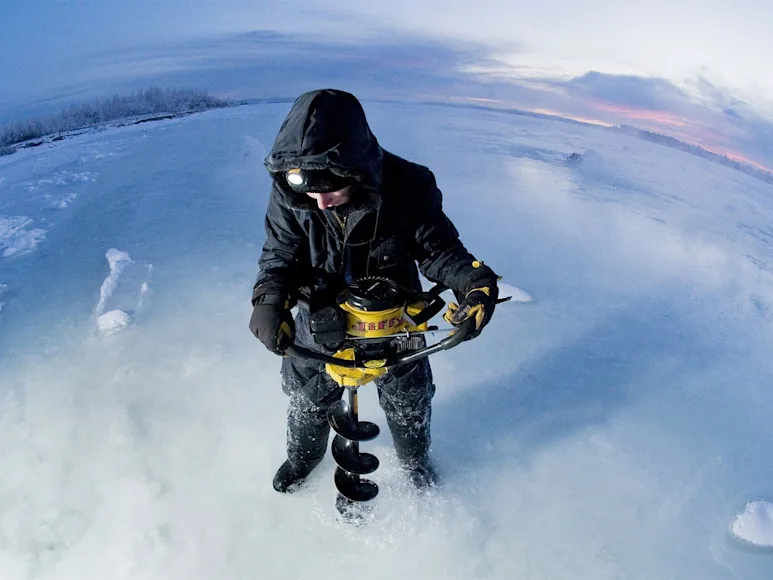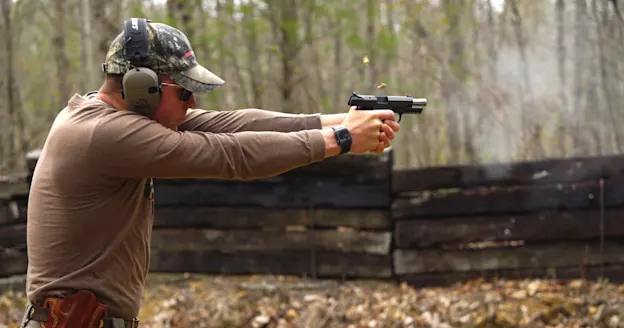_We may earn revenue from the products available on this page and participate in affiliate programs. Learn more ›
_
Best Down Jacket
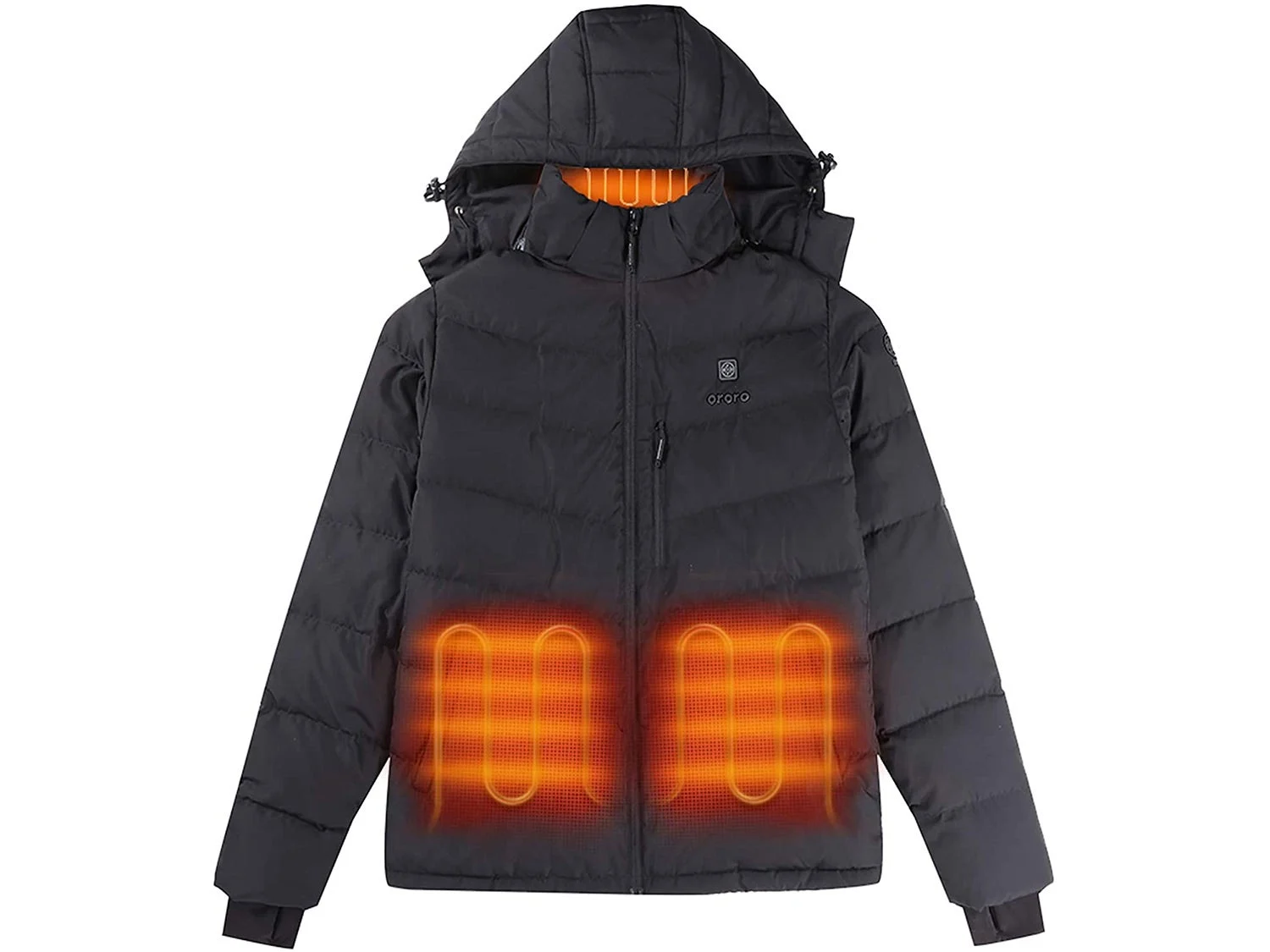
Ororo Heated Jacket with Down Insulation
LEARN MORE
Summary
A heated collar and hand pockets bump up the comfort in this heated, water-resistant down jacket.
Best Motorcycle Jacket
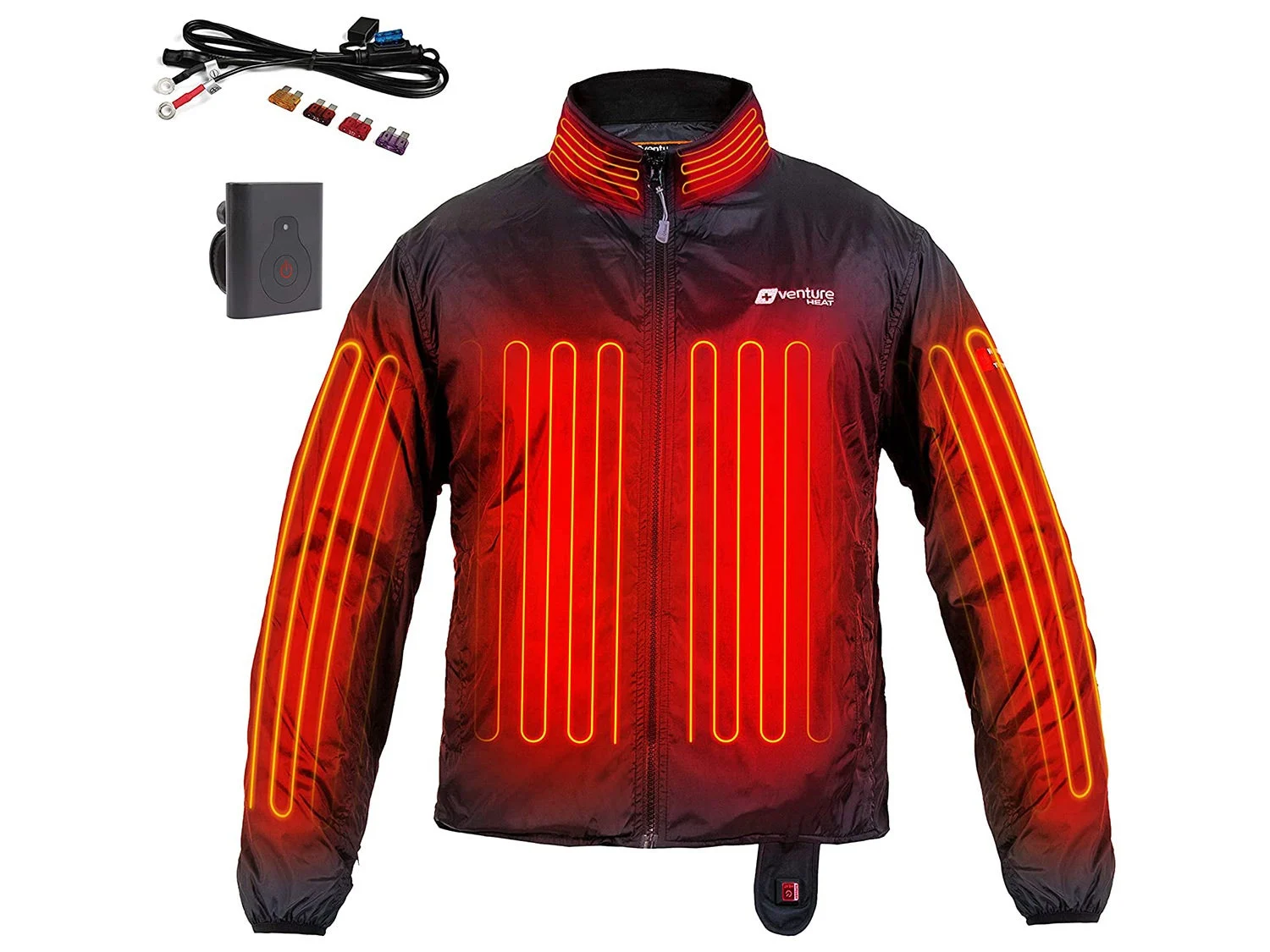
Venture Heat 12V Motorcycle Heated Jacket Liner
LEARN MORE
Summary
Your bike’s battery powers the warmth in this heated motorcycle jacket.
Best for Outdoor Work
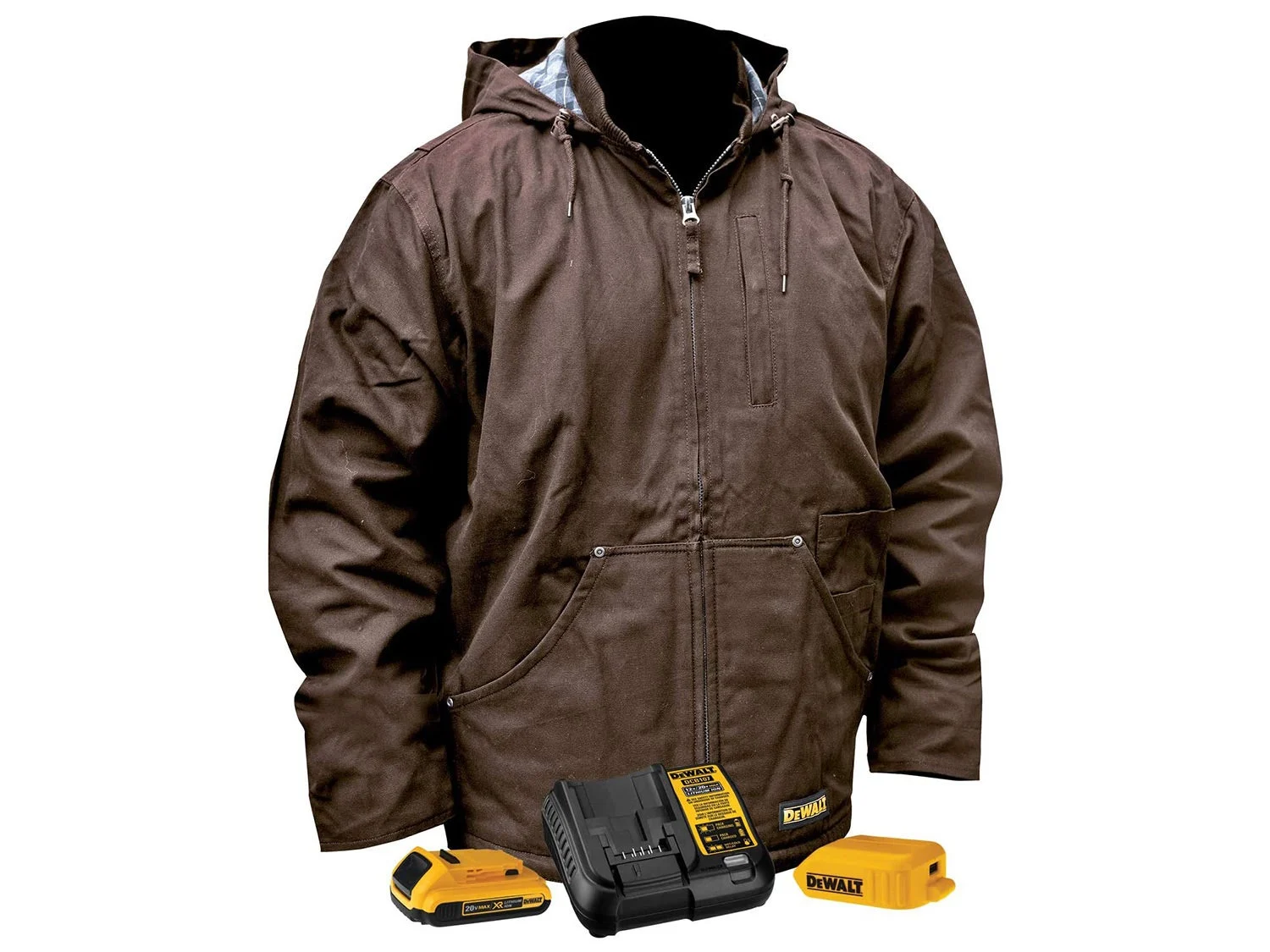
Dewalt Heated Heavy-Duty Work Coat
LEARN MORE
Summary
Heavy-duty fabric and multi-zone heating—including arms—make this the best heated jacket for working outdoors.
Winter jackets provide plenty of insulation, but sometimes, you need something more—like a heated jacket. That’s even more true when you’re outdoors for an extended period or in extreme cold. Heated socks
and gloves have their place for your extremities, but to help your body maintain its temperature, it’s all in the core. And that’s where heated jackets and vests concentrate their heat.
Some are sold with batteries, others without, so make sure you supplement accordingly. Consider picking up a compatible backup battery or power bank, so you’re not left out in the cold. We’ll walk you through the main uses and considerations to help you find the best heated jackets for your lifestyle and needs.
Best for Hunting and Fishing: Milwaukee M12 Heated Toughshell Jacket
Best for Outdoor Work: DeWalt Heated Heavy-Duty Work Coat
Best Motorcycle Jacket: Venture Heat 12V Motorcycle Heated Jacket Liner
Best for Women: Ororo Women’s Heated Parka Jacket with Thermolite Insulation
Best for Men: Milwaukee Men’s M12 Heated Axis Jacket
Best Down Jacket: Ororo Heated Jacket with Down Insulation
Best Budget: Foxelli Heated Vest
Best Heated Jackets: Reviews & Recommendations
Best for Hunting and Fishing: Milwaukee M12 Heated Toughshell Jacket
Best for Hunting and Fishing
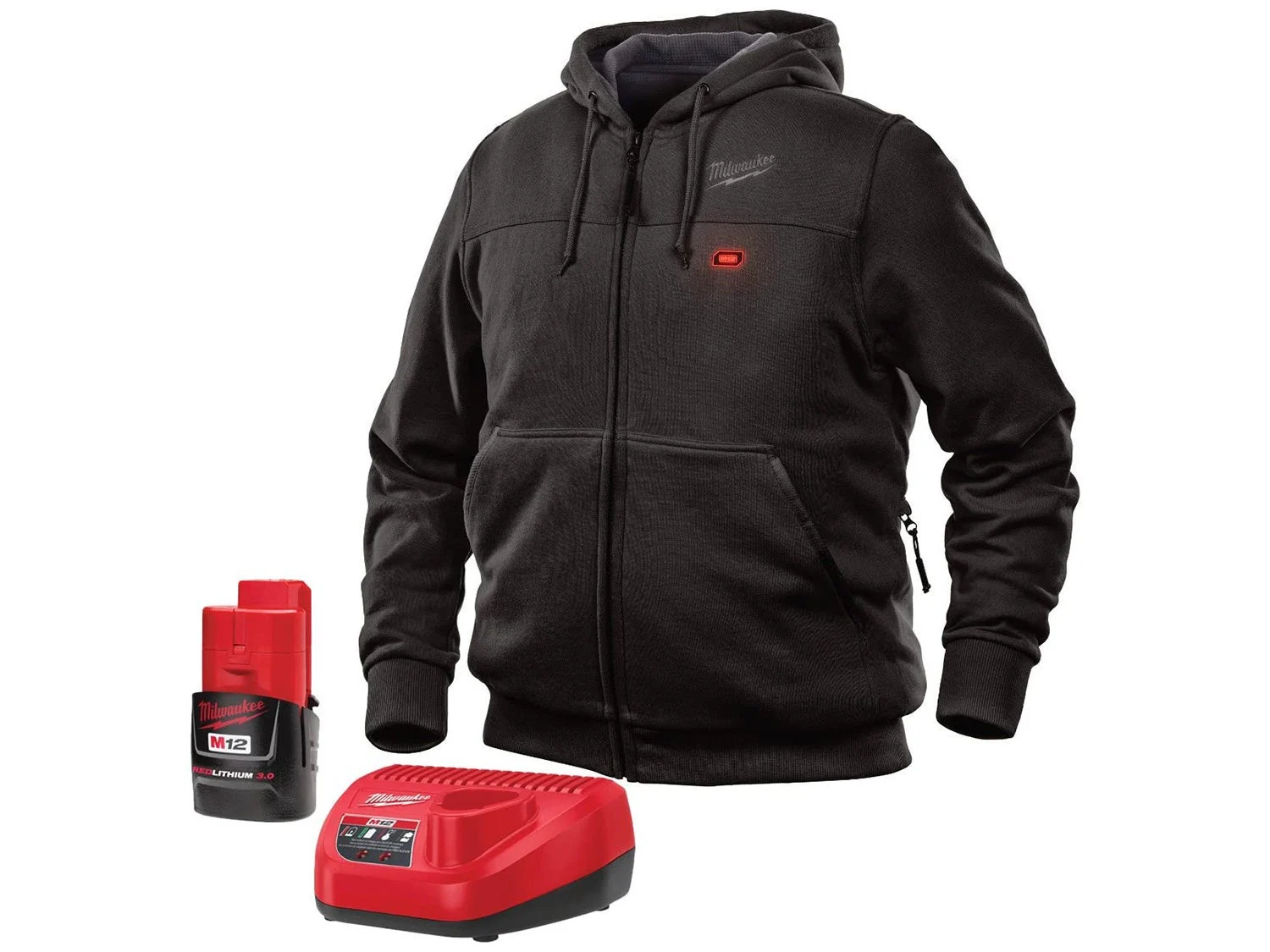
Specs
Volts: 12V
Power Source: Rechargeable Batteries
Water Resistance: None
Pros
Washer and dryer safe
Fitted hood can be worn under helmets and hats
3 heat settings
Cons
No water resistance
The hoodie just got a whole lot hotter. Carbon-fiber heating panels are in the chest and back of this washer-and-dryer safe hoodie. Two layers—a cotton-poly exterior blend and a waffle-weave thermal interior—add to the warmth, while the hood and pockets offer warmth for the head, neck, and hands. A zip-front readily allows for ventilation and ease of wear, and without much bulk, the hoodie is ready to wear under another hunting jacket or coat in more extreme weather. It heats to three temperatures (and lasts six hours on the lower setting on one battery charge, fewer hours on higher temps) and has a built in pocket for the battery.
Bonus for Milwaukee tool users: The Milwaukee heated jackets use the same M12 rechargeable lithium-ion batteries as their tools.
If you’re in that camp and don’t need the battery and charger, you can also buy just the heated jacket
. Otherwise, snag a couple extra M12 battery packs
.
Best for Outdoor Work: DeWalt Heated Heavy-Duty Work Coat
Best for Outdoor Work

Specs
Volts: 20V
Power Source: Rechargeable Battery
Water Resistance: Some
Pros
Heats chest, back, and arms
Water and wind-resistant
Can be powered by any Dewalt battery
Cons
Not as durable as a Carhartt
This DeWalt heated jacket is ideal for the job site. A heavy-duty duck fabric exterior and fleece lining make it wind-resistant, water-resistant, and warm. Five heating panels (right and left chest, each arm, and mid-back) keep you warm no matter the conditions. A ribbed collar and cuffs add an extra barrier against the elements. Gusseted underarms allow for unrestricted movement.
This jacket lets you hook up a USB charger to the battery, and has enough pockets for your essential needs, as well as an extra battery or two—and takes the same 12v and 20v lithium-ion batteries as DeWalt tools
.
Best Motorcycle Jacket: Venture Heat 12V Motorcycle Heated Jacket Liner
Best Motorcycle Jacket

Specs
Volts: 12V
Power Source: Motorcycle Battery
Water Resistance: Yes
Pros
Weather-resistant
10 heat control settings
Compatible with most motorcycles, ATVs, and snowmobiles
Cons
No external power option when off of the motorcycle
Seven microalloy heating panels—two on the chest, two one the back, two in the sleeves, one in the collar—create a light, flexible jacket with maximum warmth. It is water- and wind-resistant on its own, but it’s really designed to be worn under your existing motorcycle jacket to drastically improve its performance in cold weather. A wireless remote lets you control the jacket from your handlebar (on/off, as well as between the three heat levels), and plugs directly into your motorcycle’s battery for ease and longevity.
Best for Women: Ororo Women’s Heated Parka Jacket with Thermolite Insulation
Best for Women
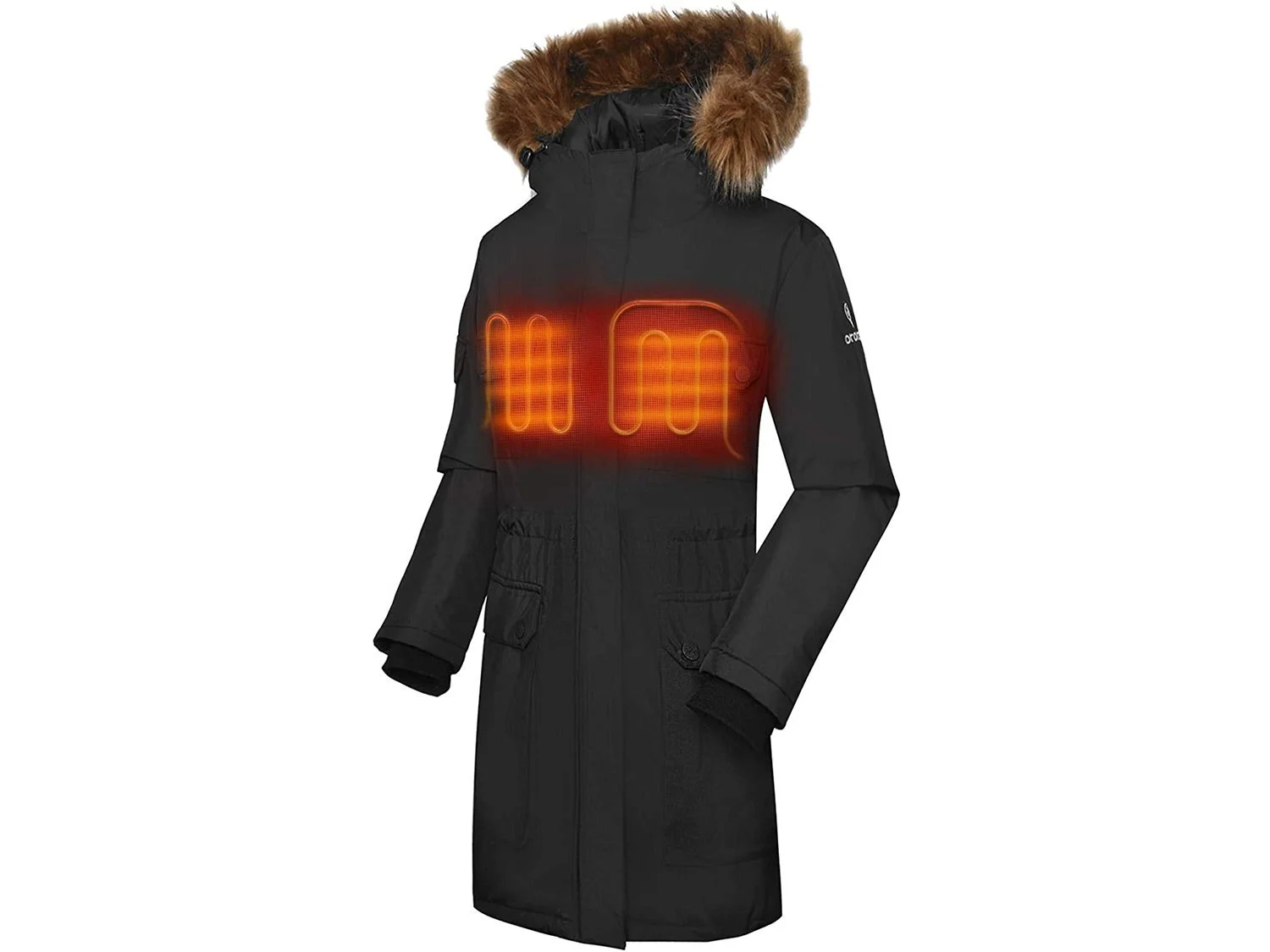
Specs
Volts: 7.2V
Power Source: Rechargable Battery
Water Resistance: Yes (DWR)
Pros
Machine washable
Waterproof coating
Adjustable heat settings
3-10 hours of heat depending on the setting
Cons
Battery doesn’t last long when on high
Not true to size
Three heat zones (two on the chest, one on the back, all carbon-fiber) can stay warm for up to 10 hours in this Ororo heated jacket, and are machine-washable for more than 50 cycles. This best women’s heated jacket is water resistant and insulated with Thermolite, and is designed with ribbed cuffs and a thigh-length body. Up-top upgrades like a fleece-lined collar and detachable faux-fur hood keep the heat inside and keep you comfortable in winter weather.
Best for Men: Milwaukee Men’s M12 Heated Axis Jacket
Best for Men
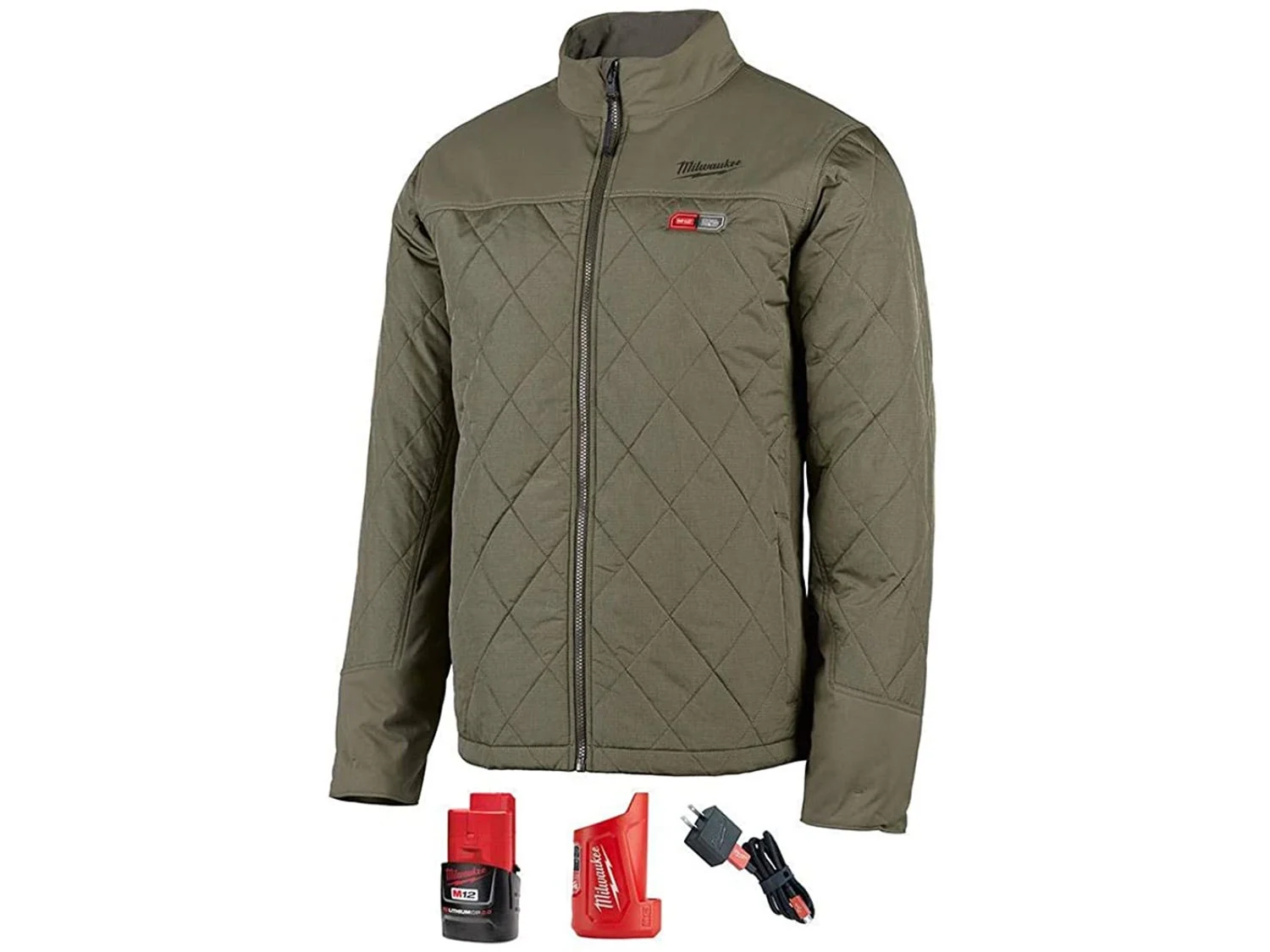
Specs
Volts: 12V
Power Source: Rechargable Battery
Water Resistance: Yes (DWR)
Pros
Up to 8 hours of run time
Reinforced and durable materials
Machine washable
Quick to heat up
Cons
Battery positioning can be uncomfortable
This Milwaukee heated jacket for men wears well for outdoor work and looks good enough to wear when you’re out at a more formal event. The quilting and fabric colors up the style side of things, while heating areas (including in the shoulders!) keep this coat as functional. It heats up quickly and runs at three power levels off of Milwaukee M12 lithium-ion batteries. It’s also lightweight (and tailored) enough to wear nicely under other coats, making it a versatile heated jacket option.
Best Down Jacket: Ororo Heated Jacket with Down Insulation
Best Down Jacket

Specs
Volts: 7.4V
Power Source: Rechargable Battery
Water Resistance: Yes
Pros
Heat placement on front is great for warming hands
Water resistant fabric
Responsible Down Standard Certified
4 heat elements including the neck
Cons
Not always true to size
The heating layout varies here from many others, with the front panels being at the abdomen rather than the chest. There’s still a mid-back panel to handle your torso’s upper half, while the lower front panels allow the carbon-fiber heating elements to warm hands
in the front pockets—and are balanced out up top with heating in the collar, too. A detachable down-filled hood (that tightens separately from the collar), cuffs with thumb holes to stay in place, and 750-fill power down (one of the highest on the general market) round out the reasons we call it the best heated down jacket.
Best Budget: Foxelli Heated Vest
Best Budget
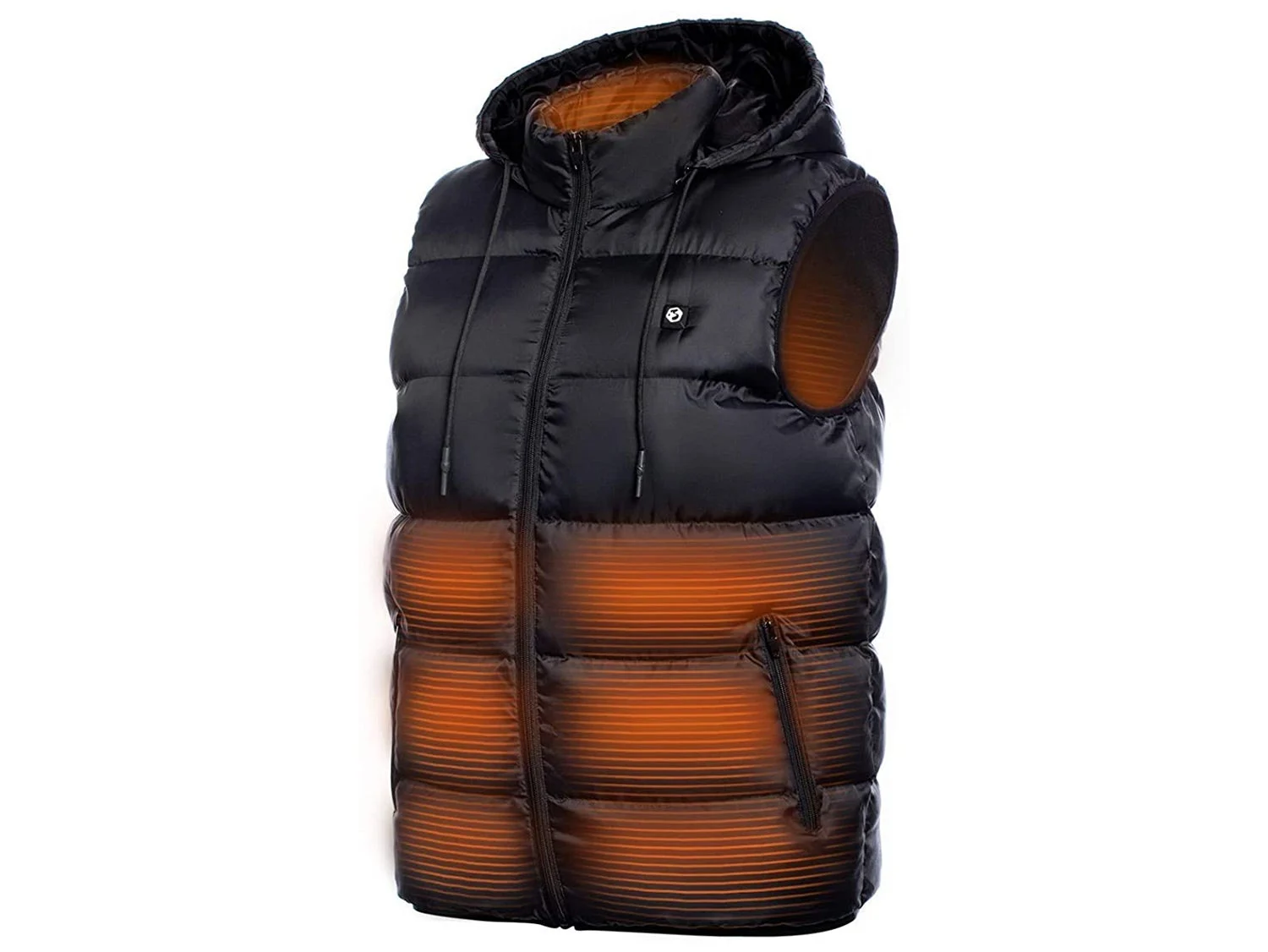
Specs
Volts: 5V
Power Source: Rechargable Power Bank
Water Resistance: Yes
Pros
Long lasting battery life
Great for outdoor and city use
Integrated hood for extra warmth
Warms up quickly
Cons
It’s a vest, not a jacket
Heating up in less than five minutes and holding heat for up to eight hours, this weather-resistant heated vest
has heating elements on the back, both sides of the abdomen, and in the collar. But the real selling point, besides the affordable price of this cheap heated jacket? Its a USB-rechargeable battery pack. That means no extra batteries, no big charger, just plug it into your car or USB outlet and get ready to go.
What to Consider When Choosing a Heated Jacket
Use
If you’re hunting or ice fishing, you’ll need a jacket that doesn’t restrict your movement or weigh you down, and will keep you warm without overheating you when you get really active—from turning an ice auger to dragging out a deer. A light heated jacket also means you can layer rain gear over it, so you’ll stay both dry and warm. These jackets are also among the best hiking jackets
because they do not restrict your movement and tend to be lightweight.
Need an orange jacket to wear over your heated jacket? Check out our top picks for the best orange hunting jackets
.
If you’ll be on a construction site, part of a road crew, or doing any type of outdoor work in cold weather, you need a heated jacket that can stand up to abuse. You don’t have time to think about protecting the jacket from damage because you have a job to do. Make sure the heated work jacket you get is designed to ward off sharp objects and resist abrasion. While many heated jackets have some water resistance, they may also need to be paired with a rain jacket
if you are outdoors for long periods.
Heated motorcycle jackets need to do everything a regular heated jacket does, but at higher speeds and in bracing winds, and without much fumbling around with controls. And the most essential difference? They should be set up to plug into your motorcycle battery, so there’s a) no limit on heat hours and b) no batteries to mess with.
Material and Insulation
With down jackets, you’re looking for a high down fill power (the rating number that frequents the 550–750 range) as your quality metric. Down jackets are often one of the best winter jackets
for insulation purposes, so adding a heat element only helps you stay warmer longer.
Budget
Most heated jackets hover around the same price range, and, in general, there’s much less variability than in other categories of cold-weather gear. To truly reduce price, you’re going to be reducing elements. One handy option is reducing the need for battery packs (but you may lose duration or intensity of warmth). Other options include solo heating elements you can wear, but they’re not integrated into insulating fibers, making them much less efficient. You can opt for a heated vest instead, which—worn as a layering piece—will still keep your body’s core warm. If you’re hunting or riding a motorcycle, however, you may want to think twice before ditching arm heating panels.
FAQs
Q: Who makes the best heated clothing?
The best heated clothing brand depends, to some extent, on you. If you already use Milwaukee or Dewalt tools, we recommend going with that same brand, as each makes their jacket batteries compatible with their tool batteries. If style (without losing sight of performance) is a priority, we like Ororo heated jackets, particularly their down option.
Q: How long do heated jackets last?
How long heated jackets last varies by maker and by use. In general, if you’re rough with the jacket, and if it’s exposed to a lot of harsh weather or washing machines, it will wear out more quickly, as will most gear. Pay close attention to the manufacturer’s instructions on care to help here. Otherwise, the battery is the main piece to consider with longevity, and the piece you may need to first replace, as they do lose power over time.
Q: Are heated jackets worth it?
If you spend a good deal of time outdoors engaged in activities that don’t keep you consistently active and therefore generating your own heat (so, hunting, hanging out, or riding a motorcycle vs. skiing or snowboarding), yes, heated jackets are worth it. They help keep your body’s core warm, which translates to being—and staying—warmer overall.
Q: Do heated jackets catch fire?
While it may be possible, it is very unlikely that a heated jacket would catch fire. Most heated jackets utilize carbon fiber heat zones, and carbon fiber has a flashpoint of at least 1800°F, making it very difficult to start on fire. Many heated jackets will also have an automatic turn-off if they get over a certain temperature or prevent short-circuiting.
Best Heated Jackets: Final Thoughts
Best for Hunting and Fishing: Milwaukee M12 Heated Toughshell Jacket
Best for Outdoor Work: DeWalt Heated Heavy-Duty Work Coat
Best Motorcycle Jacket: Venture Heat 12V Motorcycle Heated Jacket Liner
Best for Women: Ororo Women’s Heated Parka Jacket with Thermolite Insulation
Best for Men: Milwaukee Men’s M12 Heated Axis Jacket
Best Down Jacket: Ororo Heated Jacket with Down Insulation
Best Budget: Foxelli Heated Vest
When looking for a heated jacket, or any heated clothing, remember that the battery is half of what you’re buying, particularly in terms of power and longevity (while you’re wearing it and in the long run). You want quality materials, a good fit, well-placed heating elements, and a good battery. (Or two or three batteries: We highly encourage back-ups if you will be wearing the item for more than a few hours and won’t be in a place where you can step out of the cold to charge back up.)
Why Trust Us
For more than 125 years, Field & Stream has been providing readers with honest and authentic coverage of outdoor gear. Our writers and editors eat, sleep, and breathe the outdoors, and that passion comes through in our product reviews. You can count on F&S to keep you up to date on the best new gear. And when we write about a product—whether it’s a bass lure or a backpack—we cover the good and the bad, so you know exactly what to expect before you decide to make a purchase.

